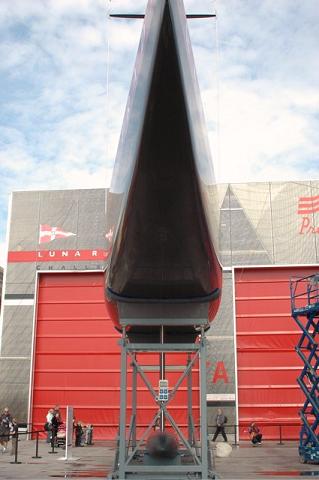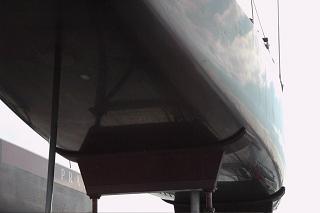|
April 1, 2007 |
||||||||||||||
Minutes before the skirts were dropped, consensus among the Cup community that no radical hull or appendage package was to be expected. Yet everyone was in for SOME surprise, ranging from great graphics on ETNZ bulb to radical square hull shape on ITA-94 (at right), or even the peculiar fact that many keels were so different, ranging from 4-5 meters to almost 8 meters ! Of all the boats, some designers admitted offline that Mascalzone and +39 looked beautiful and interesting. Philippe Palu de la Bariere, Designer of China Team, declared his preference to ETNZ "based on its esthetics." Asked to call out his choice, United Internet Team Germany's designer Axel Mohnhaupt had the right answer, "I will name my preferred boat once the Cup is over." All designers applauded in laughs. Many of the two-boat teams presented a short/fat round bulb on a lighter round boat and a more narrow hull with longer bulb. No new bowsprits were presented today, and Team Shosholoza's RSA-83 will be only team to have this feature for Act 13. Odds are we won't see a sprit on other boats for the Louis Vuitton Cup either. When asked in press conference why they did not keep the sprit on USA-87, Ian "Fresh" Burns, principal designer of Oracle, reckoned this made for more complex handling, and the risk of losing a race because of a sheet dropped under the bow was too high. While Alinghi's Rolf Vrojlik admitted the Defender came to a similar conclusion, Shosholoza's Jason Ker did reply that after a review of pros and cons and training in both configurations, the sailors opted to keep the bowsprit on Shosholoza. Asked about the particular hull shape of ITA-94, Claudio Moletto commented that the trend was definitely for narrow boats, about 2-meters less beam than Italy's first ACC in 1992, Il Moro di Venezia. Luna Rossa is a quite radical design, made for sailing upwind with a lot of heel. Luna Rossa analyzed the trade-offs between upwind and downwind advantages and decided to focus this second boat on upwind performance, with very straight sections. Giovanni Ceccarelli explained in his turn that +39 spent a lot of time on CFD analysis, and opted for a huge rake of about 5 degrees, which is new to the class, targeting a particular wind range. Dimitri Nicolopoulos stated Areva focused greatly on structural design, to save a lot of weight on the hull and deck and improve righting moment with a heavier bulb. FRA-93 was modified at the very last minute, as the team fit their new bulb last night ! Mascalzone's Harry Dunning described their decision to build two different appendage packages, and it will be up to the sailors to decide which boat they'll sail in Act 13 and beyond, depending on expected weather forecast. "Järv was designed for boat handling," explained Mani Frers. "Only difficulty we faced is that the Victory Challenge sailors were used to the older generation of boats, with little modifications to accommodate Orm to the v5 rule, and this was quite a radical change for them." Hosting a very interesting press conference in their team base, Oracle BMW Racing designers explained the tidbits of the various areas analyzed by their team of thirty experts. Ian Burns praised sponsor BMW's input, which lead, for example, to the use of Formula1 type ceramics in critical parts of the boat, including bearings. BMW Oracle's seven top designers commented on what they saw today, and many were surprised by the differences in hull shapes and appendages, admitting it was more a function of detail refinement rather than radical differences. Juan Kujumdjian and Bruce Farr analyzed the design choices of Alinghi, Luna Rossa and Emirates Team New Zealand (see photo at right), which all presented boats with fuller and longer bow sections. Bruce Farr suggested Oracle instead opted for boats which would perform better in the waves, stressing the light winds and wave chop generated by spectator fleet in the America's Cup.
It was then up to Alinghi to host their designers' press conference, and once again a lot of confidence was shown in the package presented today. Asked about the potential limits of their bow sections in waves, Grant Simmer suggested this was not a problem. Later in the afternoon, Rolf Vrojlik commented that Alinghi found themselves comfortable enough to push both boats in the same design direction, but also admitted that the Defender has a lot more time to test, develop and change their boat if needed, while other teams will be focusing on racing their way up the challenger series to grab the Challenger title and the Louis Vuitton Cup. One suspects these Swiss boats will evolve some more over the next month.... Asked about Alinghi's appendages and their interaction with hull design, Michael Richelsen (CFD) and Dirk Kramers (Chief Engineer) replied it was a very open relationship and there were a lot of combinations available. When Richelsen said that "Depending on how you want to mode the boat, you may combine this hull with that appendage, and it makes for a very large matrix," Dirk Kramers simply added "...And it's so complicated that depending on weather conditions, you'll never get it right. You will just be less wrong." --©2007 CupInfo |


